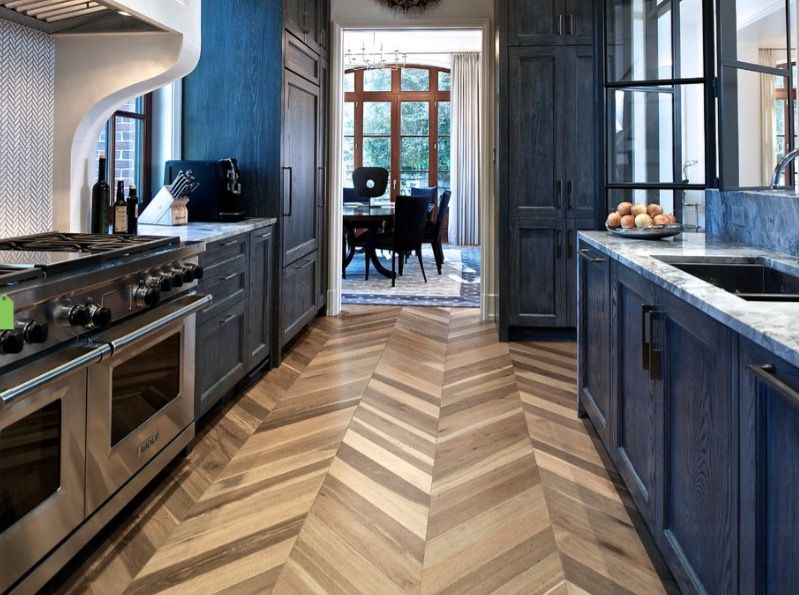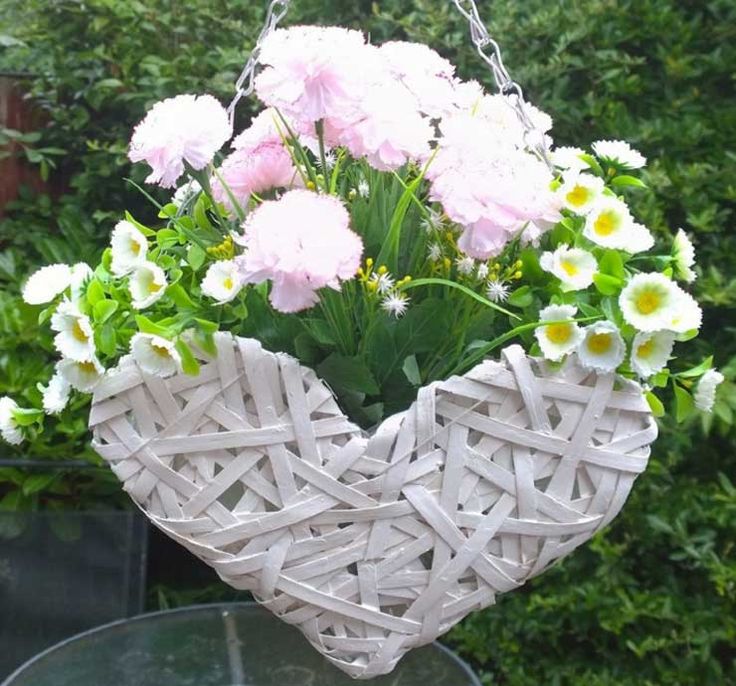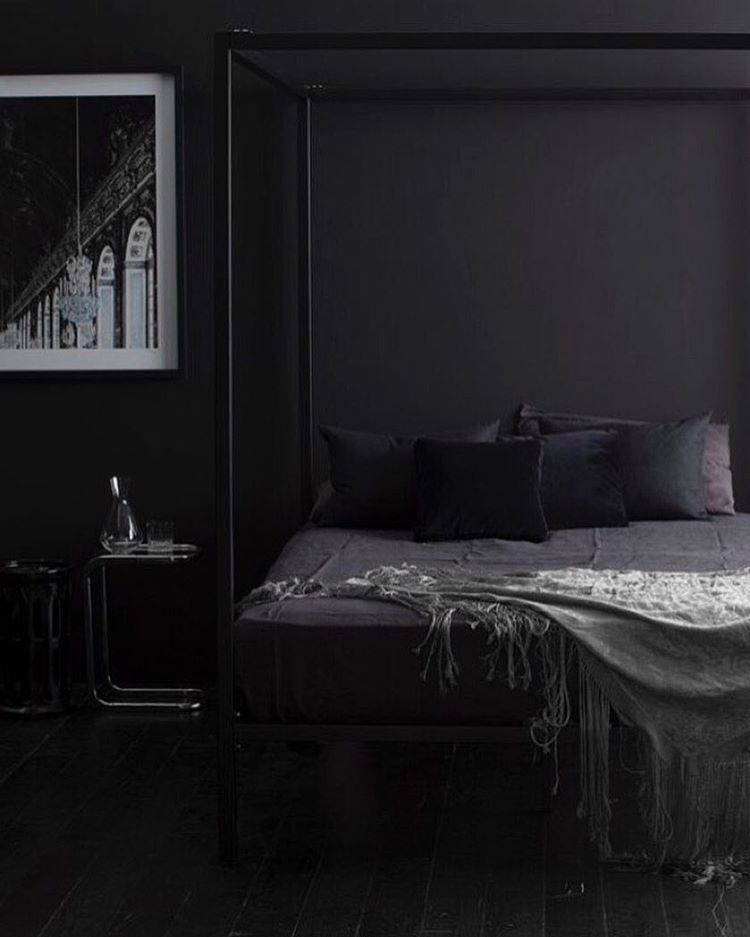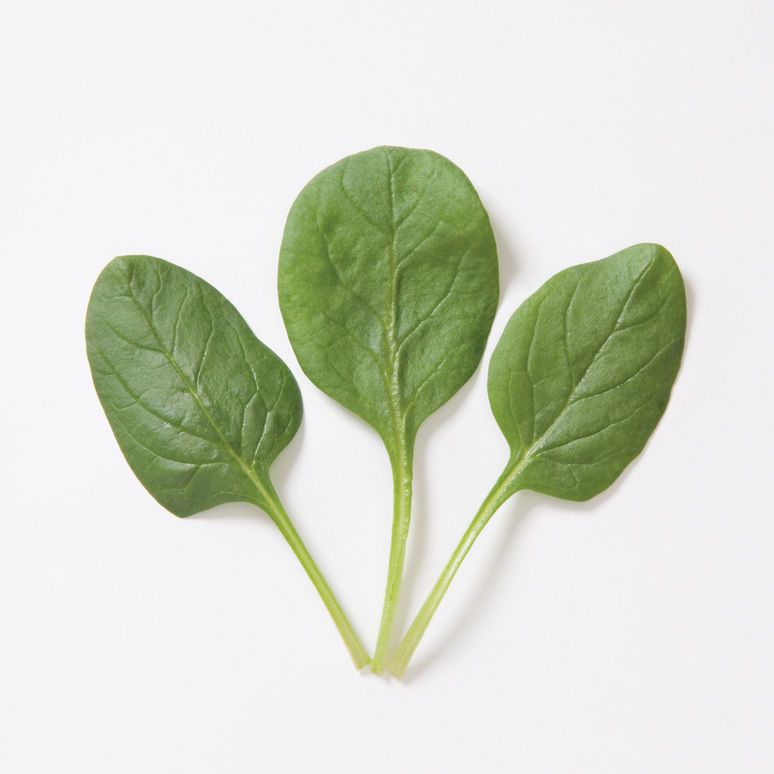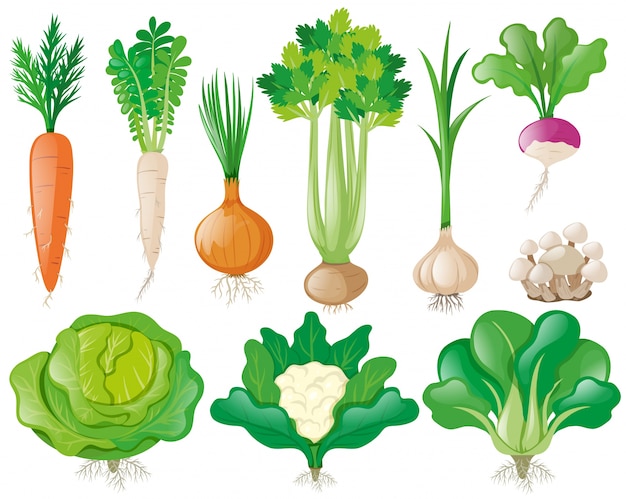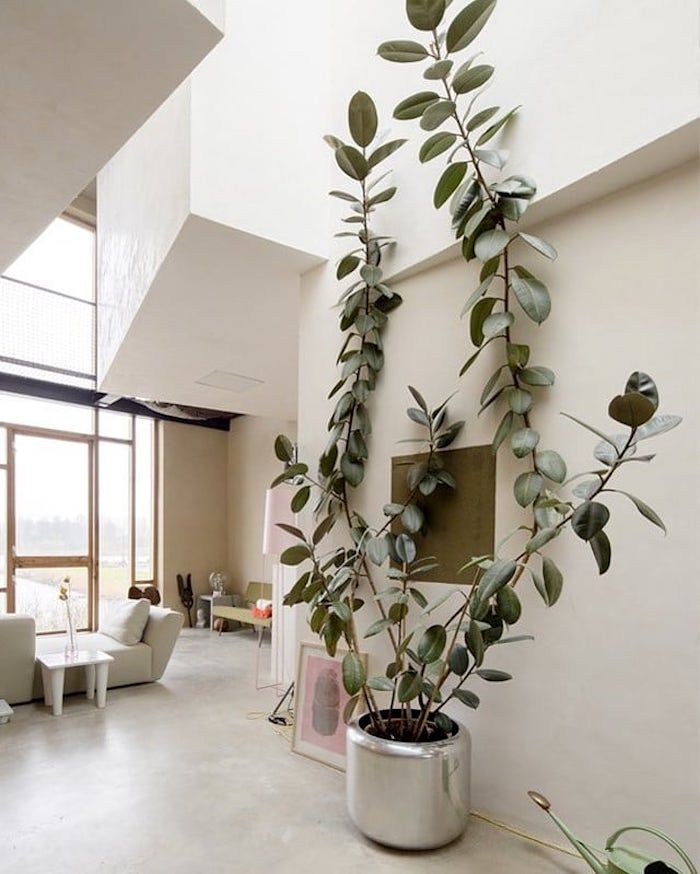How to choose kitchen flooring
How to choose the best kitchen flooring in 2021
(Image credit: Future)
The best kitchen flooring has to score highly in terms of its practicality, while its aesthetic qualities are equally vital to any aficionado of great interior design.
Yet, despite these twin demands, there are many different types of flooring that are available to suit a whole range of kitchen ideas.
The best kitchen flooring options
With the breadth of choice in mind, the question of how to choose the best kitchen flooring is crucial. Each kitchen flooring option has its particular qualities, along with its care demands, and some can suit certain households and lifestyles more than others.
We explain the best kitchen flooring options for all spaces.
Kitchen floor tile
(Image credit: Original Style)
Kitchen tile is a hygienic, attractive and easy to clean flooring option. While it’s one category, there are in fact an array of materials from which kitchen tile can be made, each with its own qualities:
Ceramic tile can be a relatively inexpensive tile choice. With a huge range of colors and patterns on offer, it makes getting the look you want easy. As well as allowing selection between finishes, such as matte and gloss, ceramic tile can also have the appearance of materials like stone and wood.
The reason you might rule out ceramic kitchen floor tile ideas? There are kitchen flooring options that are more hard wearing and which could therefore be preferable in a busy household.
Ceramic is also more porous than porcelain tile. This is less crucial in a kitchen than a bathroom, but lower porosity can help prevent staining.
Porcelain tile can also be a choice that’s fairly easy on your pocket when considering kitchen tile costs, although it will likely cost more than ceramic. Once again, there is a wide choice of color and finish, plus the availability of both plain and patterned tile makes it easy to achieve the style you want in the room.
Like ceramic, porcelain can create the illusion that it’s made of natural stone or wood.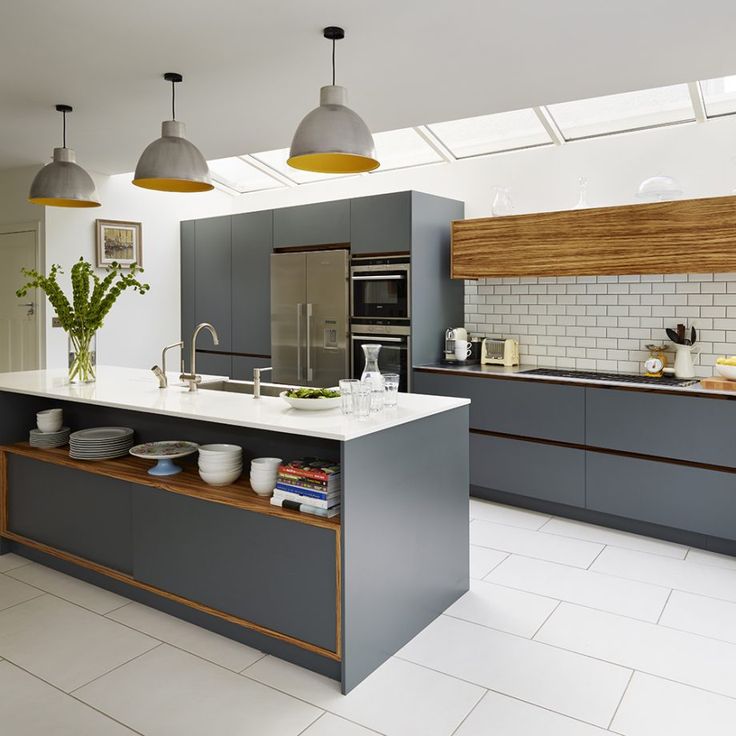 Porcelain is simple to clean and care for, extremely durable, and hard to damage.
Porcelain is simple to clean and care for, extremely durable, and hard to damage.
There are few downsides, but porcelain isn’t kind to dropped objects because it’s so hard. Like ceramic, it can also feel unyielding underfoot and, unless it’s teamed with underfloor heating, will feel cool which can be unwelcome in some climates.
Natural stone tile is a stylish and durable kitchen flooring choice. Pick from stones such as granite, limestone, travertine, marble and slate, which each have their own inherent characteristics of color and veining. Natural stone gives your floor a unique quality that can’t be attained with manmade options.
While it’s hygienic as a flooring and easy to keep clean, natural stone requires more care than ceramic or porcelain flooring. Stone is porous in different degrees, and therefore sealing is necessary to prevent stains. Sealing at installation, or pre-sealed tiling, is a must, and natural stone will also need to be resealed at intervals over the years.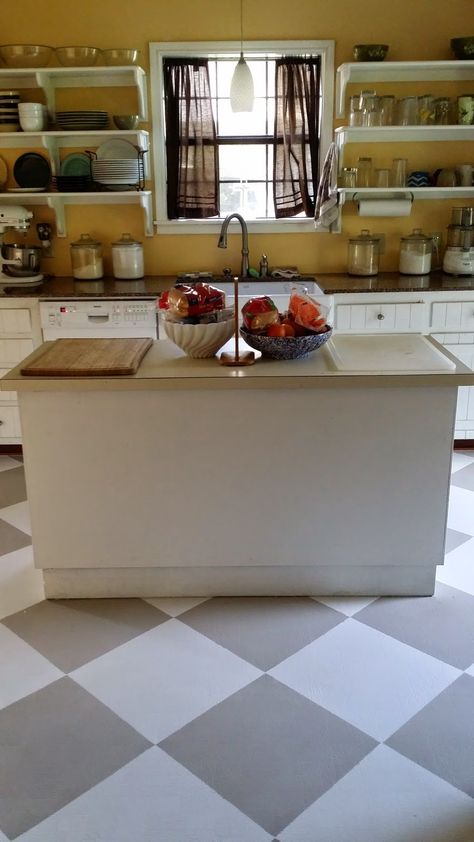
Like other tiles, natural stone is a surface which isn’t forgiving if an item is dropped, doesn’t offer any give underfoot, and without underfloor heating feels cool, which may be an unwelcome sensation depending on where you live.
Wood kitchen floors
(Image credit: Chiselwood)
Wood kitchen flooring can strike a warm and welcoming note. Select between solid timber and engineered versions, which both come at a wide range of price points.
Engineered wood flooring should be your first consideration for practical reasons. The advantage of engineered wood flooring is its structure, that makes it more dimensionally stable in the changing temperature and moisture levels caused by the cooking process.
Solid wood flooring isn’t out of the question, although some suppliers don’t recommend it as an option for kitchens. If it is your preference, excellent ventilation for the room is crucial, and it’s advisable to check the warranty before purchase.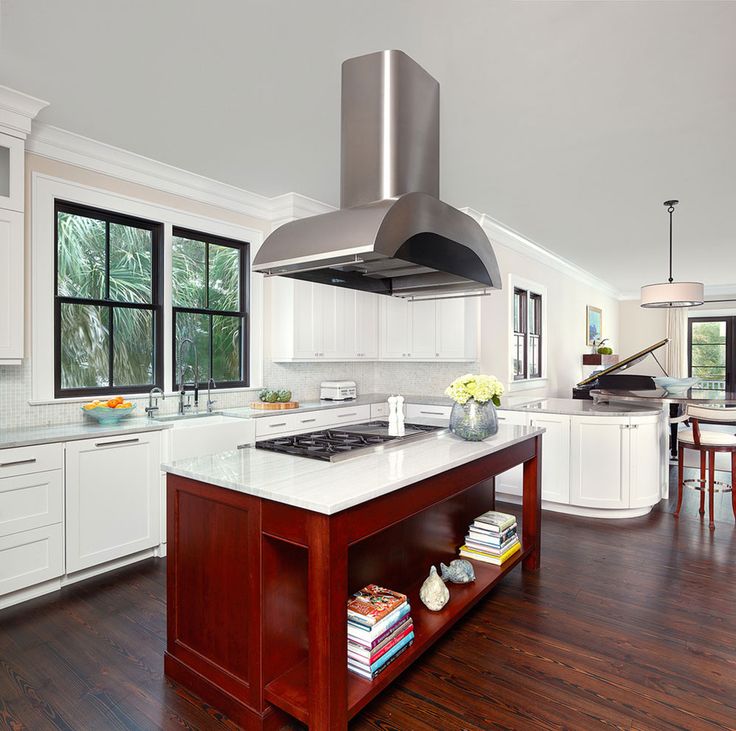
It is possible to scratch, stain and mark wood flooring, but its advantage is that it can be sanded and re-finished if necessary. Wiping up spills straightaway and regular cleaning should avoid this becoming necessary.
Wood flooring is a little more forgiving on the feet than tile, as well as naturally warmer.
Vinyl kitchen floors
(Image credit: Amtico)
There are plenty of vinyl kitchen flooring ideas that are as functional as they are stylish and will suit a variety spaces. Made using PVC, vinyl is durable, water resistant and easy to clean and maintain. It can be an especially good choice for family homes, as it’s more yielding as a surface than tile or wood and feels warmer. It’s also quieter underfoot.
Luxury vinyl tile (LVT) can look convincingly like surfaces such as wood or tile – including natural stone as well as patterned designs – so using it because of its other benefits needn’t mean compromising on the appearance you prefer.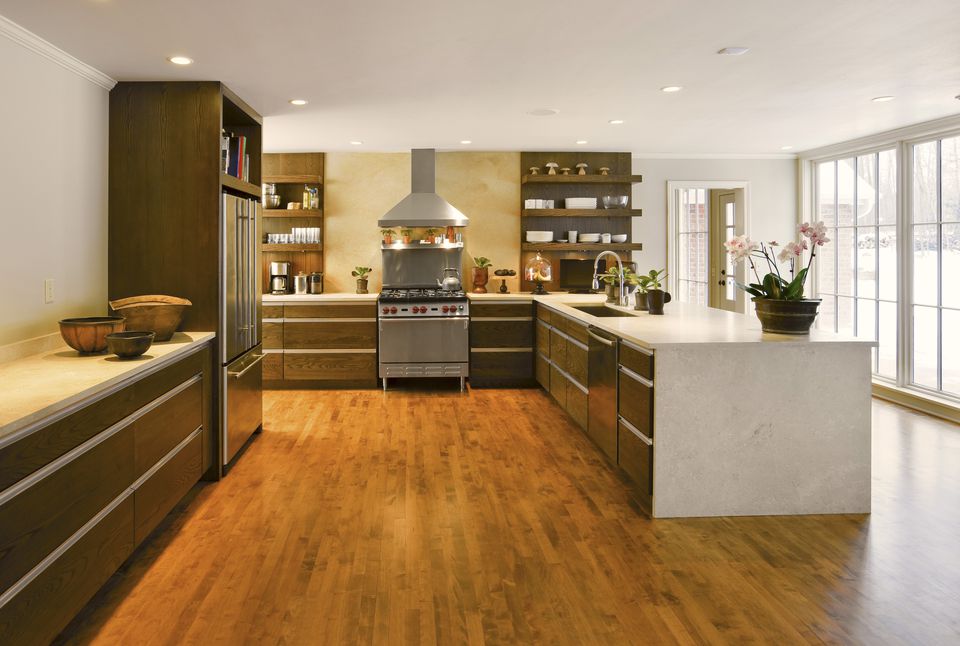
However, there are also plain colored versions in quiet neutrals and vivid shades, offering plenty of design possibilities. Another benefit of LVT is that should it become damaged an individual tile or plank can be replaced.
When it comes to kitchen flooring costs, high quality LVT is a mid-range option. Avoid cheap sheet versions as they’re thin and won’t offer the same properties.
Linoleum and cork kitchen floors
(Image credit: Haro )
If you like the idea of an alternative to kitchen tile or wood, but want an eco-friendly option, linoleum and cork could be the best kitchen flooring for you.
Linoleum is made from materials such as linseed oil, pine rosin, wood flour, pigments, limestone and jute. It’s hard-wearing, repairable if it does become damaged, easy to clean and maintain, and will resist water and stains. It’s available in a wide range of colors and finishes.
In a home with young kids, it might also be a top choice as it’s softer underfoot than tile and wood, quiet and warm.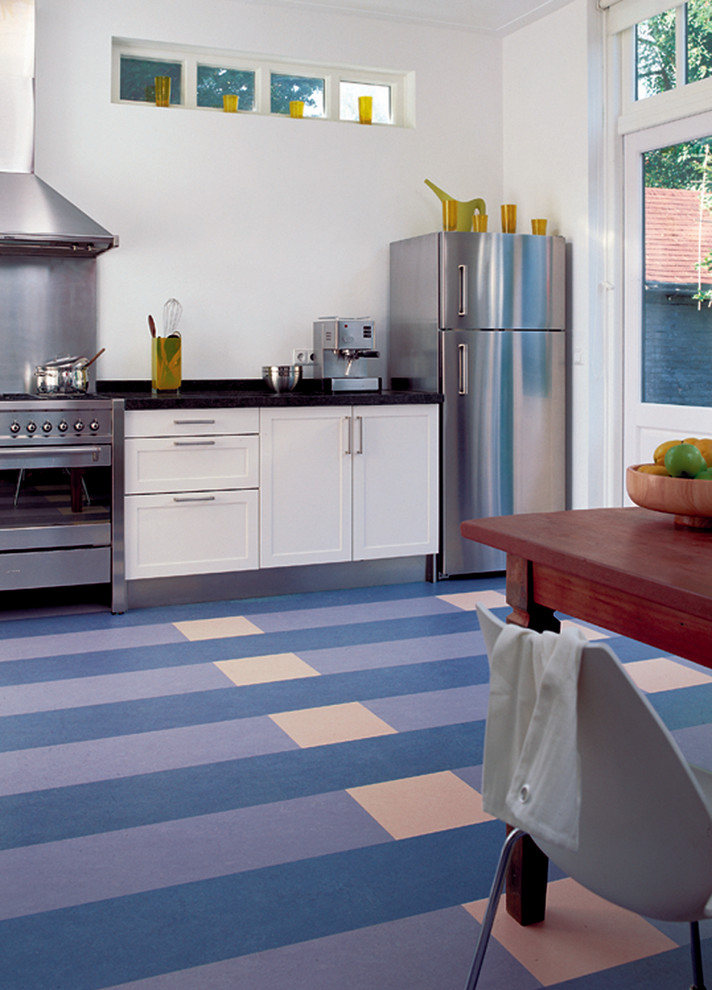
Be aware that high heels can mark linoleum, and it can be scratched. Excessive humidity isn’t good for it either.
Cork flooring is derived from tree bark, so is another natural ‘green’ flooring choice for a kitchen. Like linoleum, it might also fulfil plenty of the requirements of a family home. It’s moisture resistant, durable and comfortable to walk on. It will also absorb sound and has natural insulation properties.
While much cork flooring comes in natural shades, there are colored versions with which to create an impactful or subtle finish.
Cleaning a cork floor is easy, but spills need to be wiped up straightaway. It might not be the best option for pet owners as claws could scratch it. On the upside, a cork floor can be refinished to freshen up its appearance.
Laminate kitchen flooring
(Image credit: Future / Robert Sanderson)
Laminate flooring is often chosen as a budget-friendly way to get the look of more expensive kitchen flooring options such as wood and stone, like in this sleek white kitchen.
A high quality laminate is hard wearing, and easy to keep clean, too. While it’s water resistant, if you’re concerned about spills in the kitchen, choosing a version with a water-repellent coating is a sensible strategy.
Like wood and tile, it’s one of the harder kitchen surfaces and noisier underfoot than vinyl, linoleum and cork. It can’t be refinished it it’s damaged either.
Polished concrete kitchen floors
(Image credit: Future / Emma Lewis)
Polished concrete flooring, for a contemporary kitchen, is definitely worth considering. There are a wide range of colors and finishes, allowing this to be a creative choice if you're looking at modern kitchen ideas.
It’s a hard-wearing flooring, ideal for heavy foot traffic and a home with pets, and it’s easy to keep clean as well. And while polished concrete has a sheen, it’s actually non-slip. Of course, it won’t be the kindest on dropped objects because it is hard, nor provide any give underfoot.
Polished concrete plus underfloor heating is a good combination, and in sunny rooms it will absorb and hold heat.
Sarah is a freelance journalist and editor. Previously executive editor of Ideal Home, she’s specialized in interiors, property and gardens for over 20 years, and covers interior design, house design, gardens, and cleaning and organizing a home for H&G. She’s written for websites, including Houzz, Channel 4’s flagship website, 4Homes, and Future’s T3; national newspapers, including The Guardian; and magazines including Future’s Country Homes & Interiors, Homebuilding & Renovating, Period Living, and Style at Home, as well as House Beautiful, Good Homes, Grand Designs, Homes & Antiques, LandLove and The English Home among others. It’s no big surprise that she likes to put what she writes about into practice, and is a serial house renovator.
4 Things to Consider When Choosing Kitchen Flooring
If you’re taking on a kitchen renovation or starting new, deciding on the right cabinets, appliances, and countertops is probably at the top of your list.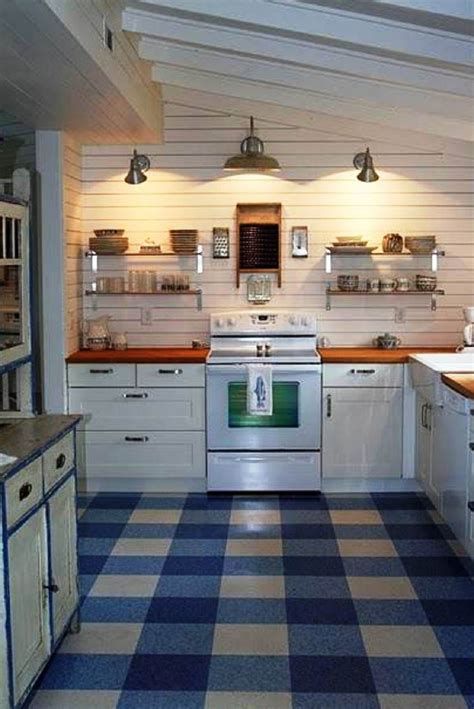 But you’ll also need to know how to pick kitchen flooring to make your kitchen design work as a whole.
But you’ll also need to know how to pick kitchen flooring to make your kitchen design work as a whole.
The options for kitchen flooring are vast. Do you go with tile? If so, what kind? What about wood? You’ve seen it in more kitchens lately, but can it withstand stains? Stone tile is always an option, but how do you choose the right one?
Your kitchen flooring choice should depend on your lifestyle, sense of style, and budget. Flooring that might look great may not function well for your family and your home. Go beyond just looks when doing your research.
If don’t know where to start in the search for the perfect kitchen flooring for you and your family, don’t worry. We’ve got four things you should consider when picking out flooring for your kitchen.
1. Material and durability
A family with young children and pets probably isn’t going to make the same kitchen flooring choice that an empty nest couple would make.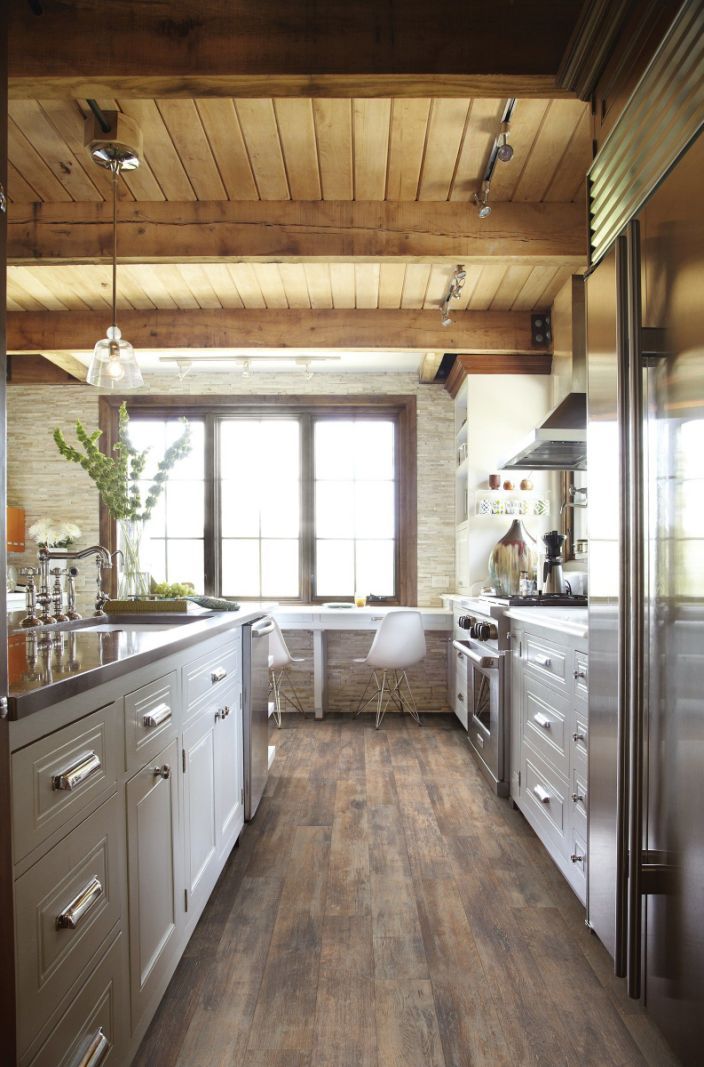 Think about what kinds of things your floor will have to withstand over the years (kid and pet messes, heavy traffic, etc.) and choose your kitchen flooring accordingly.
Think about what kinds of things your floor will have to withstand over the years (kid and pet messes, heavy traffic, etc.) and choose your kitchen flooring accordingly.
Things to consider when choosing kitchen flooring:
- If you have young children, or elders, at home, nonslip floors are an important safety feature.
- If your kitchen is a heavy-traffic area, consider stone and tile, which are durable.
- If you anticipate a lot of dropped pots and pans, or other heavy abuse, ceramic tile could be a good choice as it resists dents and scratches.
- Heavy traffic and potential water stains don’t mean you shouldn’t go with wood. Prefinished wood floors can withstand both.
- If your kitchen is off the garage or pool, choose a flooring type that can withstand muddy boots and shoes and wet towels and feet.
When making your choice, remember that durability is an important factor. You don’t want to deal with cracked tiles, stained wood, or slippery floors.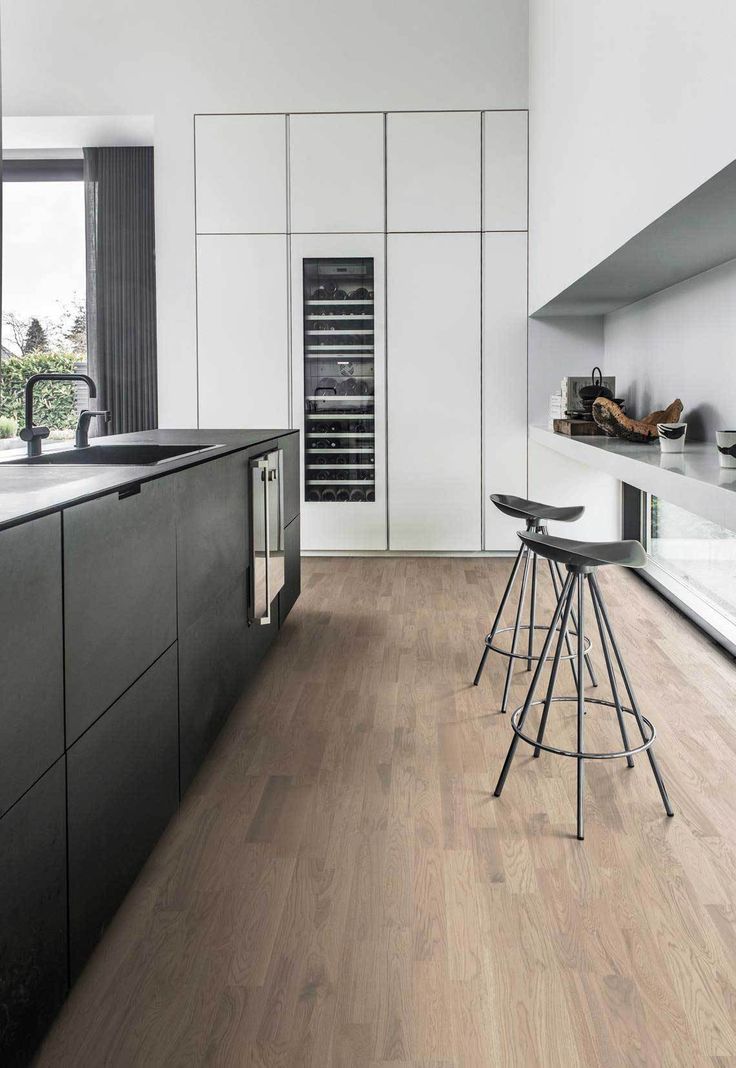
2. Your sense of style
While durability is an important aspect of choosing kitchen flooring, your sense of style also deserves input. Choose a flooring option that complements the rest of your kitchen design.
When picking out the design, color scheme, look, and feel of your kitchen, don’t leave flooring out of the equation. Does your flooring choice match the colors you’re using for your walls, cabinets, and counters? Does it look good with the various textures and patterns in your kitchen design?
Decide whether your kitchen floor will be a focal point (think black and white checkered tile) or a neutral backdrop (a soft beige, off white, or gray) for the rest of your kitchen. If you’re making a bold kitchen flooring choice, make sure it’s something you won’t get sick of in a few months or even years.
3. Maintenance
You don’t want to spend all of your time in your new kitchen cleaning, scrubbing, or worrying about stains on your kitchen flooring. Pick a flooring option that fits your lifestyle. Is it important for you to have flooring that is water- and stain-resistant, and easy to clean?
Pick a flooring option that fits your lifestyle. Is it important for you to have flooring that is water- and stain-resistant, and easy to clean?
Consider what kind of upkeep you’ll have to do on different flooring:
- Limestone is porous, and needs to be sealed when installed, and twice yearly.
- Factory-pretreated wood flooring is a durable choice, though wood floors need to be resealed every five to six years.
- Concrete flooring (a trendy option these days) requires little to no maintenance.
- If you choose tiles, the grout will need periodic special cleaning to fight stains and sealing.
Of course, we can’t tell you exactly how to pick your kitchen flooring because it all depends on your lifestyle and your wants and needs. But upkeep and maintenance should be an important factor in your decision.
4. Budget
For some, finding affordable kitchen flooring is the most important aspect of the search.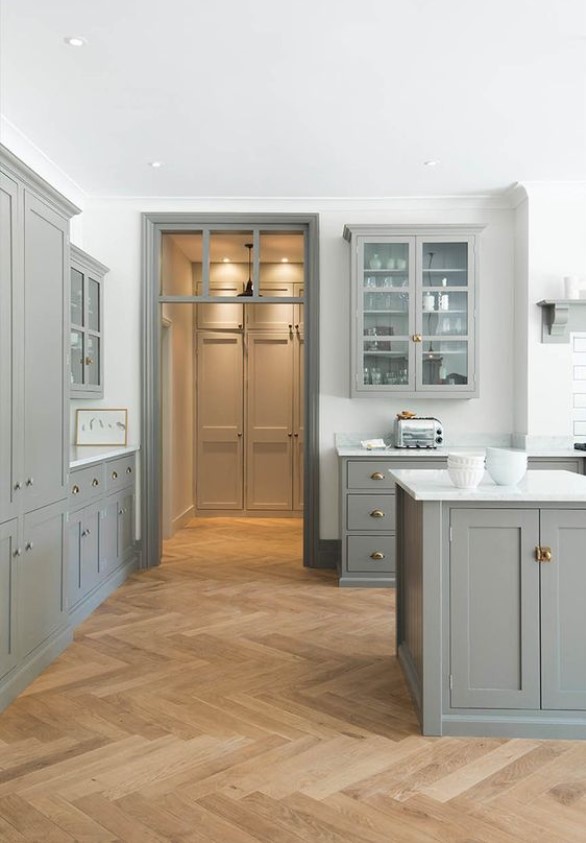 Don’t fall in love with a floor you can’t afford, and if you do look for a less-costly alternative. Flooring options can run the gamut, from $2 to $75 per square foot, before installation.
Don’t fall in love with a floor you can’t afford, and if you do look for a less-costly alternative. Flooring options can run the gamut, from $2 to $75 per square foot, before installation.
Consider some alternatives if your budget doesn’t allow the material you really want. Instead of wood, high-pressured plastic laminates provide a similar look. Vinyl or resilient flooring comes in a variety of styles and colors, and you can pick from tiles or sheets.
While it’s best not to break the bank when choosing your kitchen flooring, don’t necessarily choose the cheapest option out there. Flooring that costs a lot less may not hold up over time, and you could end up needing a new floor a lot sooner than a flooring choice that is a little more expensive. Consider your options carefully.
Many feet will pass through your kitchen in the years to come. Consider your kitchen flooring options carefully, then enjoy your new kitchen!
Related Categories
Design TrendsSarah Lograsso
As Director of Marketing and Portfolio Management, Sarah has successfully coupled her design talents with business acumen to refresh, refine and distinctly position five standout brands in the North American market and abroad.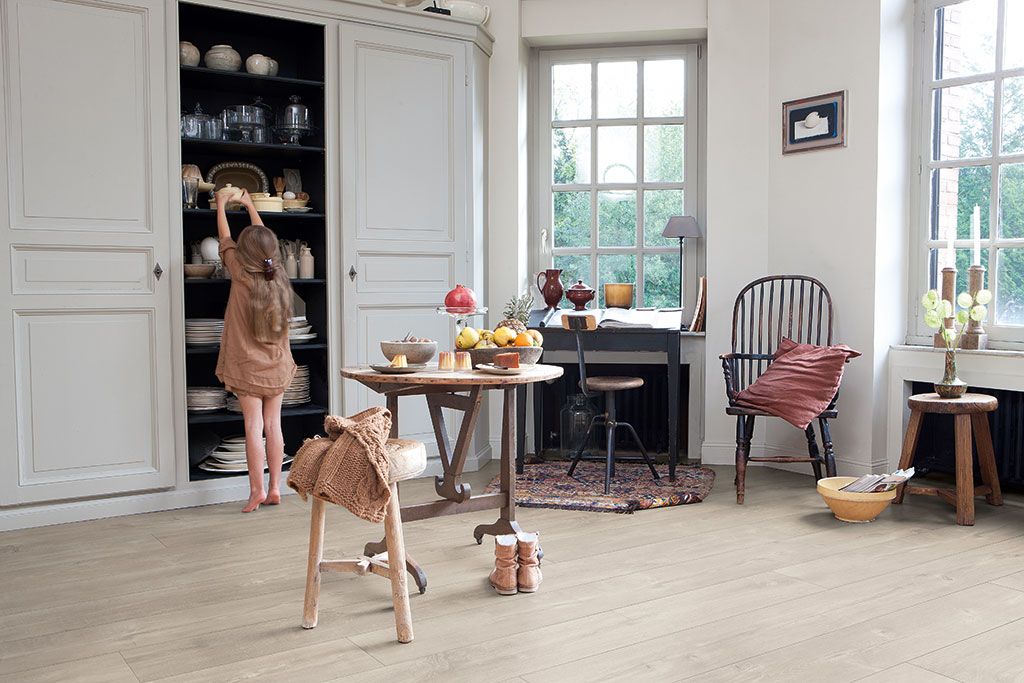 She continues to provide design direction for the brands’ variety of best-selling modern profiles and trend-forward color palettes while enhancing the prestige of the category among masons, builders, designers, architects and consumers.
She continues to provide design direction for the brands’ variety of best-selling modern profiles and trend-forward color palettes while enhancing the prestige of the category among masons, builders, designers, architects and consumers.
What is the best floor for the kitchen? Tips from PlazaReal in St. Petersburg
During the overhaul of an apartment, the question inevitably arises of what is better to make the floor in the kitchen, what materials are preferable, what can and should not be used for this purpose. We give an overview of the most popular flooring and demonstrate how they look in the interior.
Which floor for the kitchen to choose so that it is waterproof, durable, beautiful and serves for many years? Focusing on the above description, the pros and cons of each material, it will be easy to understand which coating will be the best finishing option in your case:
- Ceramic tiles are based on natural clays of various grades, pressed and fired at high temperature.
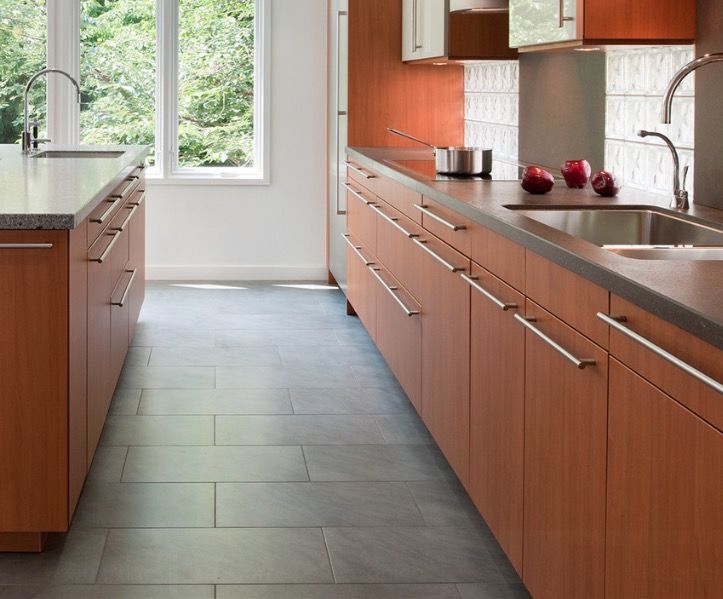 The most important features are durability and environmental friendliness.
The most important features are durability and environmental friendliness. - Vinyl tile is a new generation multilayer material. Produced by hot pressing. Combines the best qualities of laminate and PVC linoleum.
- Porcelain stoneware - made from kaolinite clays, quartz sand, feldspars and coloring pigments. It is fired, acquiring the strength of a monolith.
- Marble is a natural rock formed from limestone subjected to high pressure. The color and pattern depends on the impurities of the minerals copper, chromium, manganese.
- Laminate - 4-layer board coated with paper or cardboard impregnated with resins. The pattern applied to the surface is covered with a protective film.
- Cork - cork oak bark, light, practically not abraded, not subject to decay.
- Linoleum - an artificial material on a foamed or monolithic basis of PVC (hard varieties) or on a polyester basis (soft). For the kitchen floor, the first ones are more practical.

Ceramic tiles
Clay tiles have been used for flooring since ancient Roman times. Until today, it ranks first among all types of floor coverings. True, it is not so easy to figure out what is better to put on the floor in the kitchen, because manufacturers offer an incredibly large number of variations of durable and beautiful floor ceramics.
Ceramic tiles for the kitchen on the floor are easily combined with any design style. You can choose an option for both classic and loft or high-tech. Interesting color panels are laid out from it. It is easy to choose an option that imitates natural granite, marble, expensive wood.
When choosing ceramics, you need to remember that wall tiles for the kitchen are not suitable for the floor, they are used only for wall cladding. As a floor covering, tiles with a hardness of at least 4–5 and a wear resistance index of at least 4 points are used. Then it will serve as long as the life of the building itself is calculated.
The floor is tiled with a trendy geometric pattern.
When figuring out which tile to choose for the floor in the kitchen, you need to remember one important point. This is a place where you can spill anything on the floor: water, juice, vegetable oil (remember Bulgakov's Annushka!). The smooth surface thus turns into a skating rink. If you are concerned about "safety", it is better to pay attention to matte, non-slip tiles.
In fairness, we note or clinker. And one more thing: due to the special hardness, when a glass or crystal wine glass falls on the floor, there are no chances of survival (unlike laminate and linoleum).
Porcelain stoneware
This modern material appeared only about 30 years ago and firmly "settled" as a floor covering in public buildings and offices. Manufacturers produce various versions of porcelain stoneware, many of which are suitable for laying the floor in the kitchen in private houses and even high-rise apartments.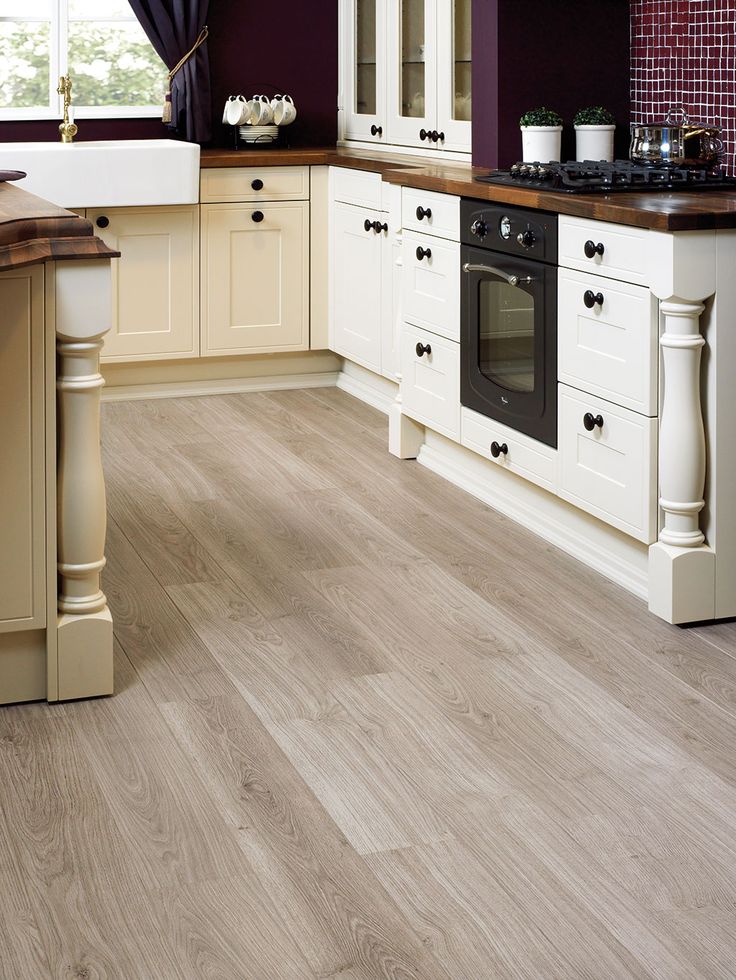
If, for example, the question is which floor to choose for a country cottage, porcelain stoneware tiles will be in place. It has a fantastic density: in ordinary ceramics, the degree of water absorption is about 10%, and in porcelain stoneware slabs it is less than 0.5%. She is not afraid of frost, has no limitations, a couple of disadvantages of a ceramic floor. It is quite cold, so usually a heating system is provided for it. In this case, you can not use tiles made of red clay: only white is suitable.
Laminate
Wood is not the best choice for covering the floor in the kitchen, as it reacts to moisture and temperature changes. For those who cannot refuse it, or the design suggests a wooden floor, a laminate will be a good alternative. The material is a two-layer plate covered with a moisture-resistant film and decorated with natural wood on the outside.
Positive qualities: the laminate is difficult to scratch, it retains its shape and original appearance well.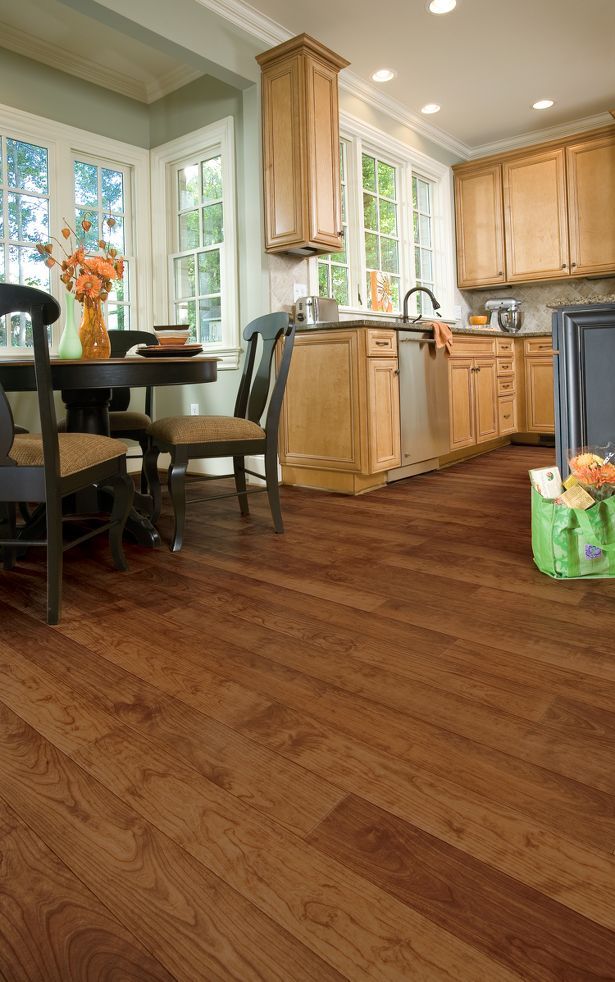 Withstands temperatures up to 28⁰C, under such a coating you can safely equip a warm floor. The variety of imitations is huge: from dark oak to light birch, smooth slabs and with a pattern of natural wood. Service life, depending on the class, 15–50 years.
Withstands temperatures up to 28⁰C, under such a coating you can safely equip a warm floor. The variety of imitations is huge: from dark oak to light birch, smooth slabs and with a pattern of natural wood. Service life, depending on the class, 15–50 years.
When choosing what is best to lay on the floor in the kitchen, you need to take into account the shortcomings of the material. So, the laminate can not be filled with water when washing. If moisture seeps through the edges, the lamellas will begin to swell. Pay attention to special varieties for the kitchen: a special moisture-resistant wax impregnation is applied to such boards on all sides, including the ends.
Laminate flooring needs to be laid on a soft substrate, but even this does not save neighbors from noise if you do not like to walk around the house in soft slippers. Do not drop pans and knives on the floor - for all the strength of the material, chips and cracks cannot be avoided in this case.
Valuable quality of a laminate with locks: a damaged board can be easily exchanged for a new lamella, so you need to leave some margin when laying.
Linoleum
When discussing which floor is better to make in the kitchen, we will definitely remember the well-deserved and once very popular linoleum. You should not compare modern varieties of this material with those that were produced twenty years ago. It has a lot of advantages: economical, wear-resistant, has a wide range of colors, is not afraid of moisture.
If you decide that laying linoleum on the floor in the kitchen will be the best option, you need to keep in mind a few rules:
- The subfloor must be level and dry. The thinner the linoleum, the stricter the requirements.
- Small bulges and irregularities will be evident, in addition, linoleum quickly wears out in such places.
- Plain or stone patterned flooring is laid lengthwise away from the window to give the flooring a more uniform appearance.
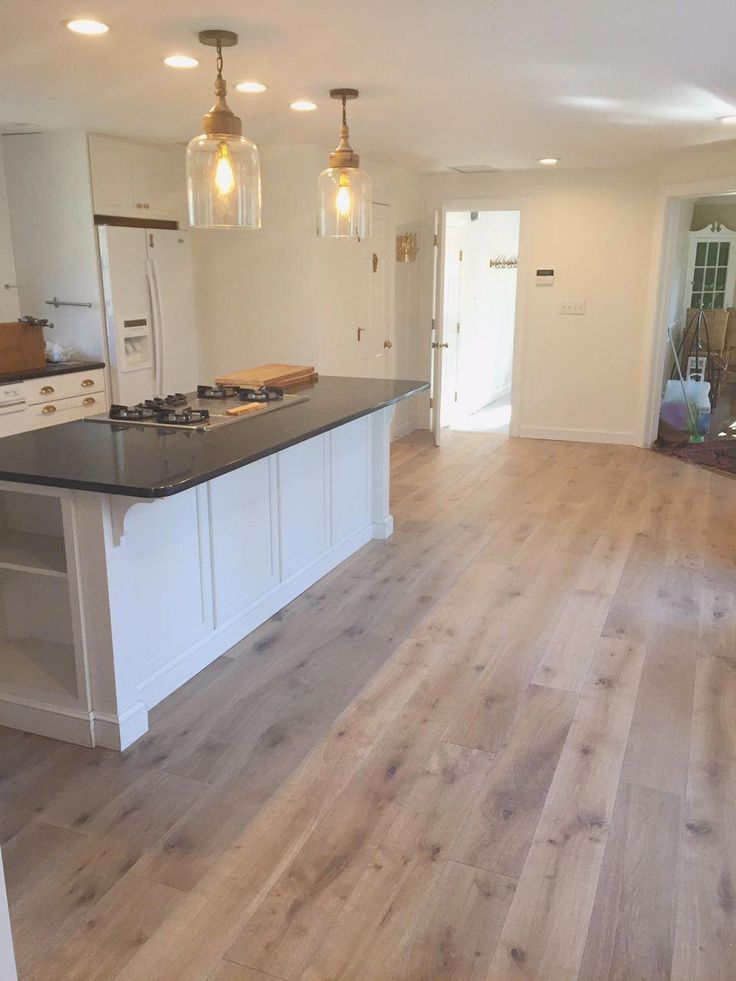
- When cutting the material, there is always a margin for "cutting" to the walls. Usually it is 5-7 cm.
- After gluing, linoleum must be “rolled” with a heavy roller or a special board.
Today, linoleum is produced not only in rolls, but also cut into tiles. This expands the design possibilities, facilitates the installation of coatings and reduces the number of scraps. The appearance of linoleum is the most diverse. It successfully imitates natural stone, wood, and even metal. Stylish modern prints allow you to choose the flooring option for the kitchen in any style.
Cork floor
The original cork floor in the kitchen is not a cheap pleasure. However, it is a very durable and environmentally friendly material. Cork is obtained from the bark of a special type of oak that grows in the Mediterranean countries. It is warm, it is pleasant to walk on it barefoot, perfectly dampens sounds, does not absorb moisture, and is resistant to household chemicals.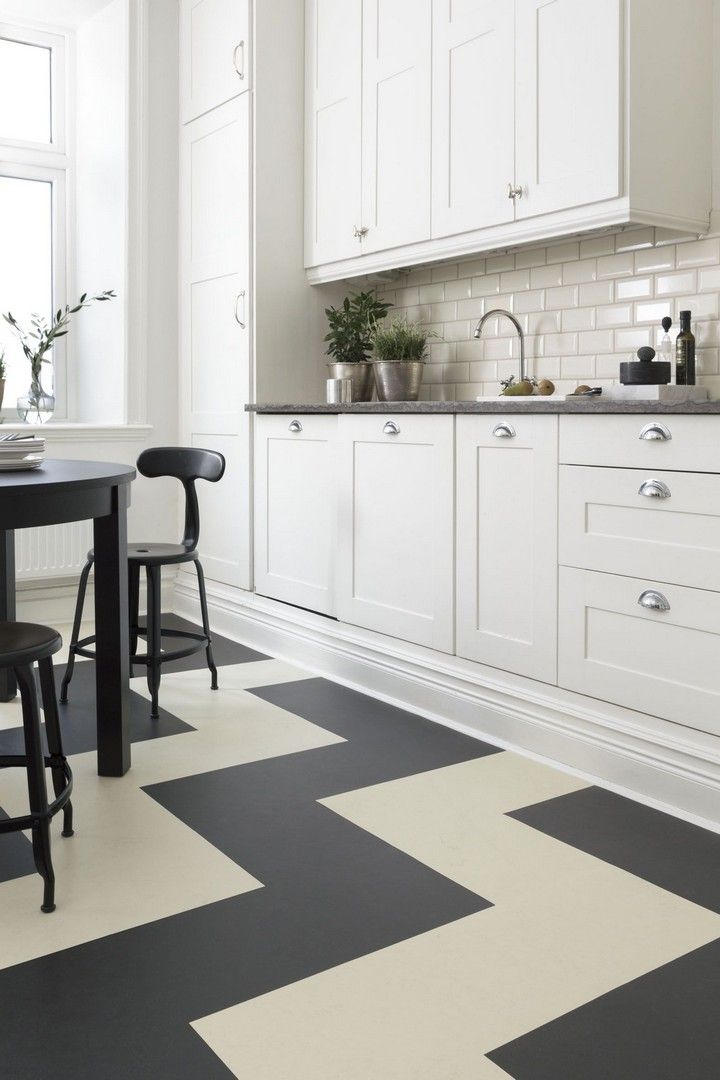 She is not liked by bugs and other rodents, she is not affected by mold. In addition, such floors have antistatic properties, which means that dust does not accumulate on them.
She is not liked by bugs and other rodents, she is not affected by mold. In addition, such floors have antistatic properties, which means that dust does not accumulate on them.
Cork is a rare and valuable material, so it is used economically. Two types of floor coverings are made from it. The first is chipboard panels covered with a thin bark veneer (0.5–1 mm). The second variety is more expensive: it is 100% natural material. The bark, crushed into crumbs, is pressed to obtain slabs, which are then decorated with veneer. Such a cork is called granular.
If you have finally found something to lay the floor in the kitchen and cork floor is your choice, please note that the plates must be varnished, or it will need to be applied after laying.
Remarkable quality of a stopper — elasticity. The cork floor is not only pleasant to walk on: it also has a beneficial effect on the musculoskeletal system, reducing the load on the spine.
Vinyl floor
A new interesting material for lovers of experiments - PVC vinyl tiles for the kitchen on the floor. This is a cross between tile, linoleum and laminate. It is quite flexible, easy to install, at the same time comparable in strength to stone, and its decorative possibilities are simply endless. In appearance, the floor can look like granite, marble, there are textures that accurately imitate wood or even leather.
This is a cross between tile, linoleum and laminate. It is quite flexible, easy to install, at the same time comparable in strength to stone, and its decorative possibilities are simply endless. In appearance, the floor can look like granite, marble, there are textures that accurately imitate wood or even leather.
Advantages of vinyl flooring for the kitchen:
- service life up to 35 years, does not fade, does not scratch;
- easy laying, does not require a perfect base;
- is harmless to health, does not emit harmful fumes;
- is not afraid of water, household chemicals, does not slip;
- is a durable material that does not crack on impact.
Of the disadvantages of vinyl tiles, only its relatively high cost can be noted. But given the indisputable advantages, it fully justifies itself from all points of view. This is a great alternative to traditional ceramic tiles.
Screed
Under the self-leveling floor in the kitchen, two different operations are meant.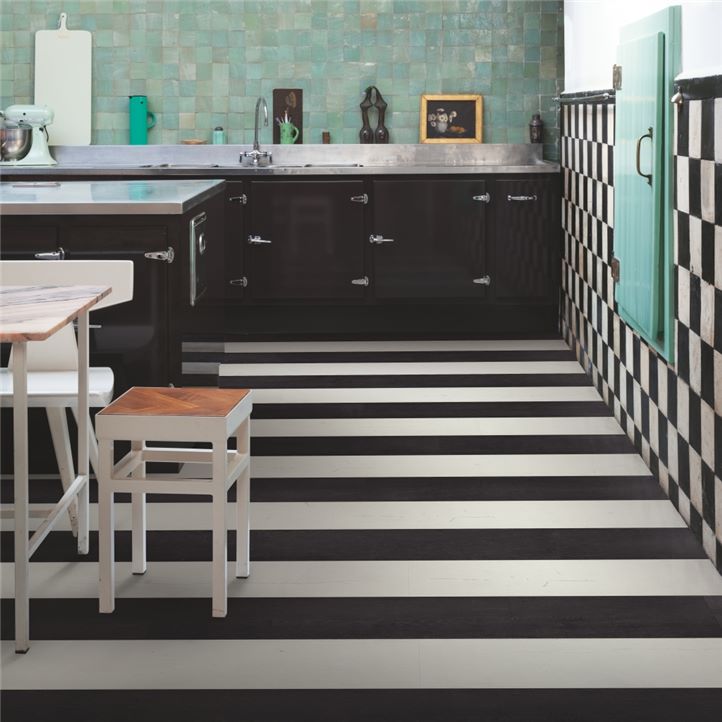 More often they mean putting the base in order before laying laminate, carpet or linoleum. This is actually getting a thin, perfectly even screed using a dry water-soluble mixture. If it is brought to a liquid (spreading) state, it is often called self-levelling. Most "levelers" have a porridge-like consistency, which is distributed with a special tool.
More often they mean putting the base in order before laying laminate, carpet or linoleum. This is actually getting a thin, perfectly even screed using a dry water-soluble mixture. If it is brought to a liquid (spreading) state, it is often called self-levelling. Most "levelers" have a porridge-like consistency, which is distributed with a special tool.
The second option for self-leveling floors is the use of mixtures based on polyurethane or epoxy resins, on which, after pouring, you can not lay another coating. The composition can be transparent or colored, various decorative elements are added to it: figurines, shells, stones. As a result, they get a kind of 3D self-leveling floors, and the kitchen turns into a real work of design art.
Marble
Natural marble floor in the kitchen is beauty, elegance, style. But there will be a lot of trouble with him. Both during installation and in subsequent operation. The greatest advantage of marble tiles is that they instantly transform the look of the room, giving it a luxurious, regal look.
Marble has many natural shades, the unique pattern of the stone is not repeated. It is easily cut, polished, acquiring a soft satin sheen. From it you can make any decorative pattern, up to a stone mosaic. It is absolutely safe, environmentally friendly material. However, like any other, it has a number of disadvantages that make it difficult to use in the kitchen:
- Brittle - Dropping heavy objects, especially metal, can cause chips, scratches, and cracks. Eliminating them is difficult.
- Reaction to acids - marble has a calcareous composition, so acidic sauces, wines, juices destroy it and leave indelible stains.
- Polished slabs are very smooth - slipping on the floor is dangerous, and falling on the stone is not very pleasant.
Marble is a porous material, so it is necessary to protect the plates from the penetration of household liquids. It is advisable to consult with experts on which flooring is best for the kitchen in order to prevent staining of the material. Marble tiles are thick and quite heavy. For it, you need to prepare a solid foundation, laying starts from the center of the room towards the walls.
Marble tiles are thick and quite heavy. For it, you need to prepare a solid foundation, laying starts from the center of the room towards the walls.
In conclusion, we note which floor to make in the kitchen is up to you. The best solution is at the intersection of practicality, relevance in design and your financial capabilities.
Back to the list of tips
Which floor is best for the kitchen: choosing the material
Top
02/16/2021
1 star2 stars3 stars4 stars5 stars
We talk about modern and traditional materials suitable for laying on the floor in the kitchen: tiles, porcelain stoneware, PVC, laminate and self-leveling floors.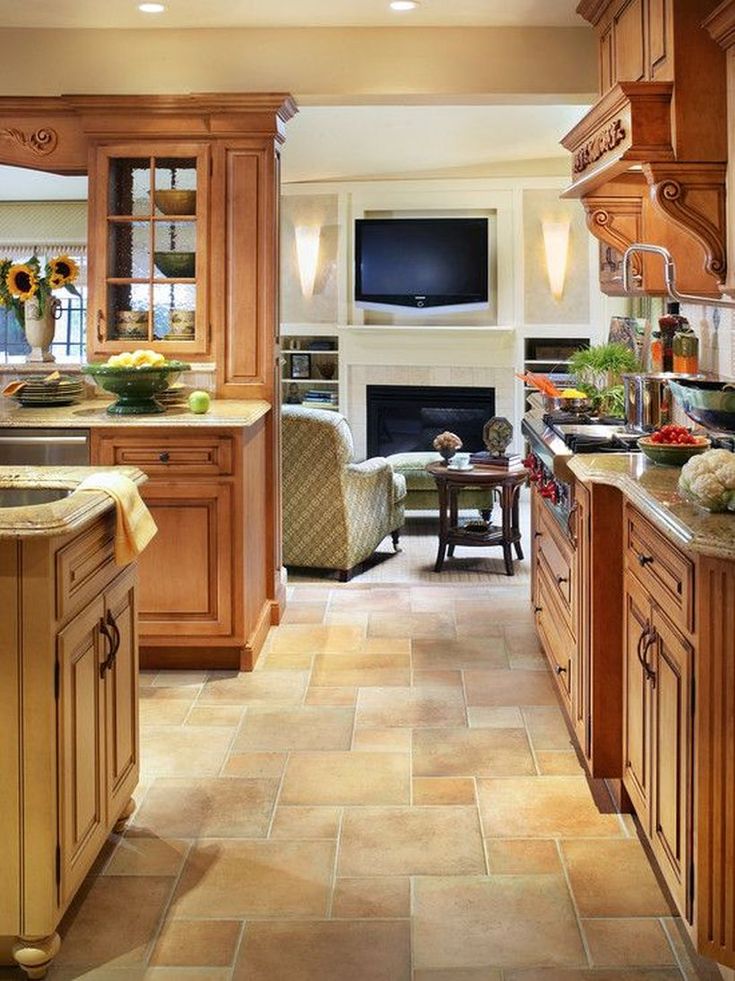
pixabay
The choice of floor coverings is wide: tried and tested for decades or recently introduced materials. Each of them has its own disadvantages and advantages. We've put together a variety of finishes. Let's characterize each one in detail to make it easier to figure out which floor is better to make in the kitchen.
Listed all the materials in a short video
How to lay the floor in the kitchen
What should be the flooring
Six options for the kitchen floor
— Tile
– Porcelain stoneware
— Laminate
— PVC
- Tree
— Self-levelling floors
Short summary
As much as one would like to choose a cladding only for its appearance, one must take into account that the kitchen is a “hard” environment. Food is prepared here, so temperature drops, steam and high humidity are not uncommon. It is undesirable that this negatively affects the condition of the coating.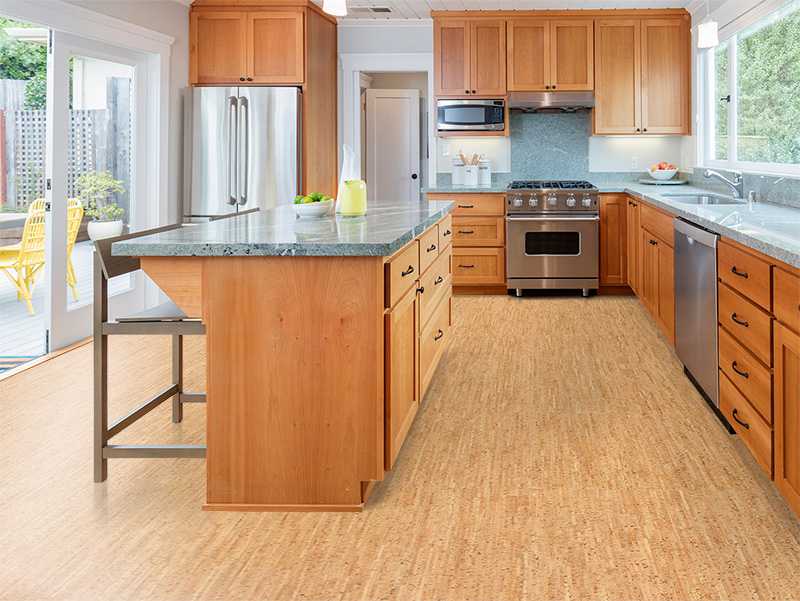 Sometimes the food burns or initially has a strong odor that can be absorbed into the pores of the finish.
Sometimes the food burns or initially has a strong odor that can be absorbed into the pores of the finish.
During cooking, liquids may spill or food may fall on the surface: greasy or colored stains will remain, which should be easily removed. Even spilled water can ruin the wrong finish. Heavy and sharp objects also often fall on the kitchen floor. Dishes fall from time to time. In order for it to remain intact, there must be a soft finish on the floor, on hard glass or porcelain will scatter into small crumbs.
And one more very important point. The finish should be easy to clean and withstand multiple cleanings. In the kitchen, stains and dirt can be very serious here. Therefore, not only soft soap is used, but also aggressive chemicals. It is better if the pollution is not very noticeable. For example, on a very dark or very light glossy finish, every crumb or speck of dust is clearly visible. It is better not to choose them for the kitchen.
Pexels
-
Finishing materials
Laminate for the kitchen: is it possible to lay and how to choose the “right” coating
Although there are many requirements for flooring, the choice of materials is very wide. We offer a selection of options from which it is better to make a floor in the kitchen.
1. Ceramic tiles
The traditional kitchen floor solution. It is moisture resistant, not afraid of temperature changes and pollution. It is easy to wash off stains, provided that the lining is not porous. The design of the tile is varied. It can be monophonic, color, imitate various materials. Tiles are available in various sizes. Ceramics are well combined in color, size and shape.
Tiles are not perfect. First of all, its surface is always cold. The situation is saved by the underfloor heating system laid under it, but this is not always possible and beneficial. Also, ceramics are brittle. A dropped knife or heavy pot will almost certainly chip or even split the tile. It can be replaced, but it's troublesome. Glass or porcelain dishes will not withstand a fall on the tile.
But, in general, ceramic tiles are one of the most practical solutions. It is not afraid of water and pollution, without loss of appearance withstands numerous cleanings and washings.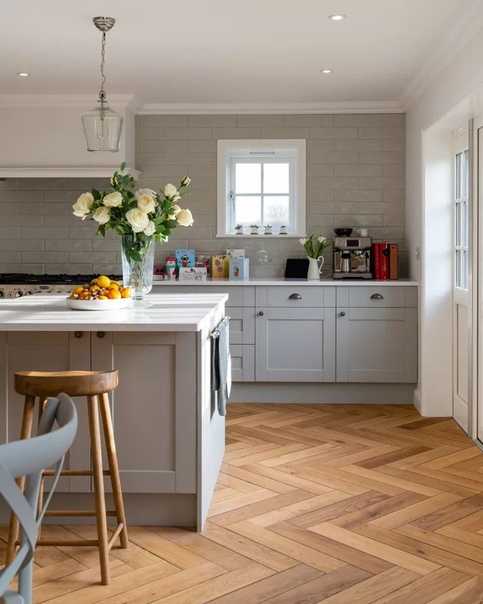 The price is quite affordable.
The price is quite affordable.
Design: Anna Elina. Photo: Evgeny Gnesin
Design: Anna Elina. Photo: Evgeny Gnesin
-
Finishing materials
Choosing tiles for the kitchen on the floor: useful tips and 102 inspiring photos
2. Porcelain tile
This is a type of ceramic tile with increased strength and durability. When laid, it easily tolerates blows; it is rather difficult to split or chip off a fragment from it. Therefore, falling knives and heavy utensils are not terrible for porcelain stoneware. Insensitive to moisture and temperature changes. Can be installed in damp areas. Available in different designs: imitations of natural wood or stone are good, but there are other options.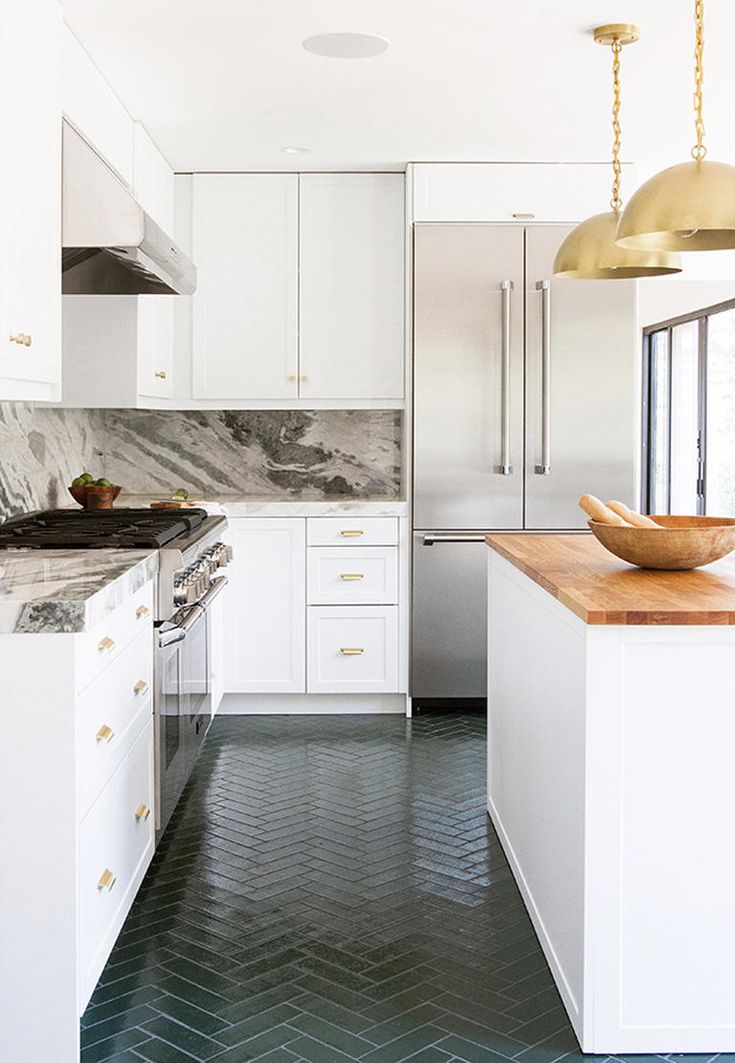 Combined in size, shape and color.
Combined in size, shape and color.
The disadvantage of porcelain stoneware is that the surface is cold to the touch. Walking barefoot on it is unpleasant, but the underfloor heating system saves the situation. If it is not possible to lay it, then it is better not to mount porcelain tiles on the ground floor or in a private house. The material is very hard, which means that the dishes that fall on it will break into smithereens. Plus, it's slippery. Therefore, it is necessary to choose a tile with anti-slip treatment.
Porcelain stoneware is well suited for the kitchen. It is easy to clean, does not deteriorate from water, does not absorb odors, durable and beautiful. The price is slightly higher than that of ceramics.
Design: Ksenia Konovalova. Photo: Olga Shangina
-
Floor
Which linoleum to choose for the kitchen
3.
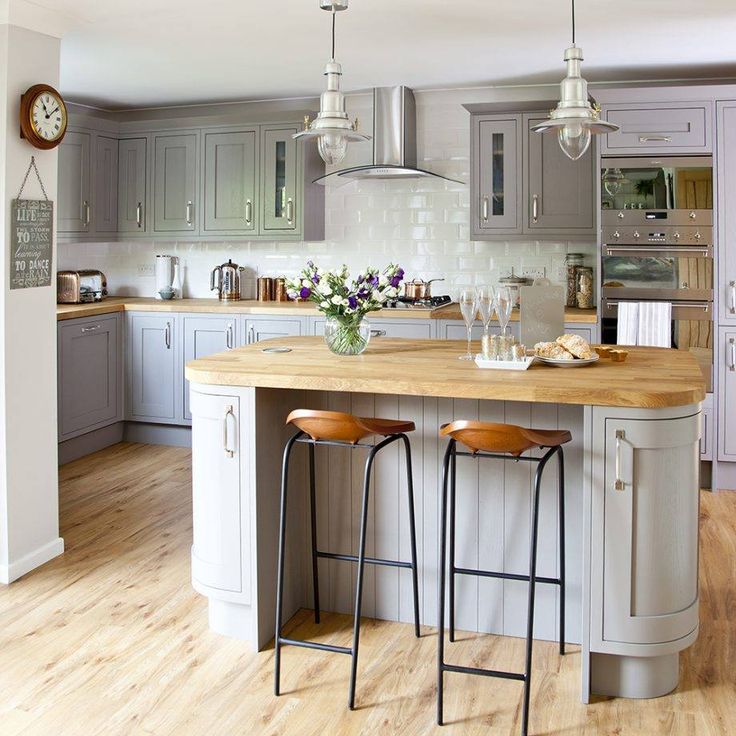 Laminate
Laminate These are multi-layer panels based on wood-based interlocking panels. Easy to fit, warm to the touch, easy to care for. It's nice to walk on them. Dishes that have fallen on the laminate will most likely remain intact. The colors and textures are very different, usually it is a good imitation of natural wood of various species, cork surface. High-quality models are durable, environmentally friendly, do not fade or deteriorate under the influence of moisture.
The weakest point of laminate flooring is the interlocks. This is where moisture can get inside the base. This leads to irreparable damage to the coating: it deforms and swells. In addition, for inexpensive models, the edges of the laminated film move away over time. They lift up and fly off, revealing the base. The panels are not sufficiently resistant to mechanical damage. For example, a knife falling from a height will certainly damage the surface.
Laminate panels are a possible but not the best choice for kitchen flooring.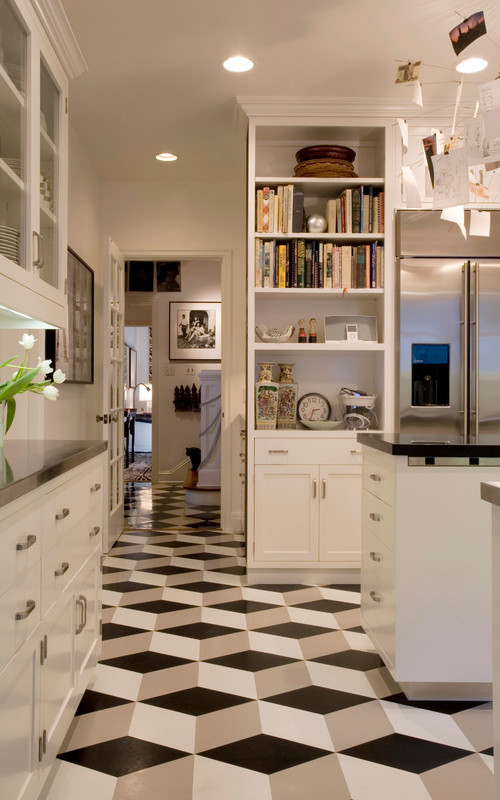 They deteriorate from moisture, are sensitive to shock, and do not tolerate frequent washing. It is best to combine them with other coatings. For example, lay out strips of porcelain stoneware near the kitchen set, and decorate the area under the dining table with laminate.
They deteriorate from moisture, are sensitive to shock, and do not tolerate frequent washing. It is best to combine them with other coatings. For example, lay out strips of porcelain stoneware near the kitchen set, and decorate the area under the dining table with laminate.
4. PVC tiles
PVC tiles are made from polyvinyl chloride with various additives. The most famous variety is quartz-vinyl cladding. About 80% quartz sand is added to it, which gives increased strength. The properties of vinyl tile are closest to linoleum. It is quite soft, moisture resistant, pleasant to the touch, resistant to mechanical stress. It cannot be split, but you can get dents under heavy furniture. Two types of PVC tiles are produced: with locking joints and for laying on glue. There are a lot of design options: sizes, shapes, textures and colors are very different.
The material has few significant drawbacks. One of them is careful preparation for installation.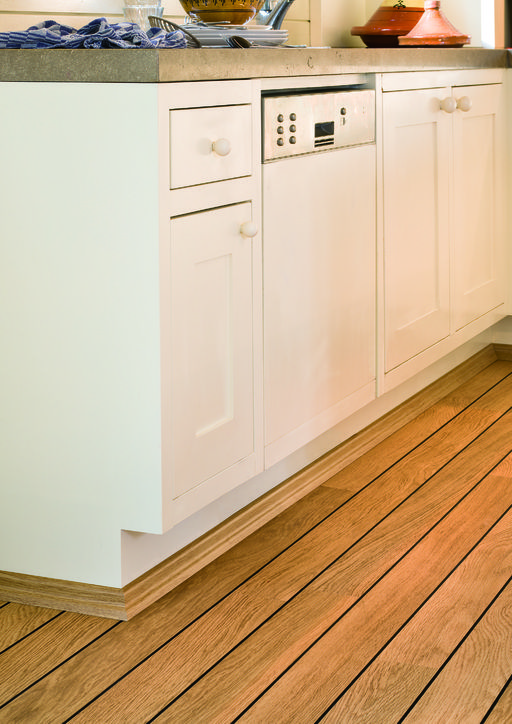 The base must be perfectly level and dry. Otherwise, all defects will be noticeable after installation. For castle models, these requirements are less stringent. Another disadvantage is the high price of PVC tiles. But we must understand that it will last a long time and will not lose its attractive appearance and properties during the entire period of operation. If repair is still required, the damaged element can be easily replaced.
The base must be perfectly level and dry. Otherwise, all defects will be noticeable after installation. For castle models, these requirements are less stringent. Another disadvantage is the high price of PVC tiles. But we must understand that it will last a long time and will not lose its attractive appearance and properties during the entire period of operation. If repair is still required, the damaged element can be easily replaced.
Vinyl is a good choice. He is not afraid of water, frequent cleanings, does not deteriorate from aggressive chemistry. Soft lamellas are pleasant to the touch, retain sound and heat.
Pexels
-
Floor
2 Easy DIY Vinyl Tiles
5. Wood
A very beautiful and ecological option.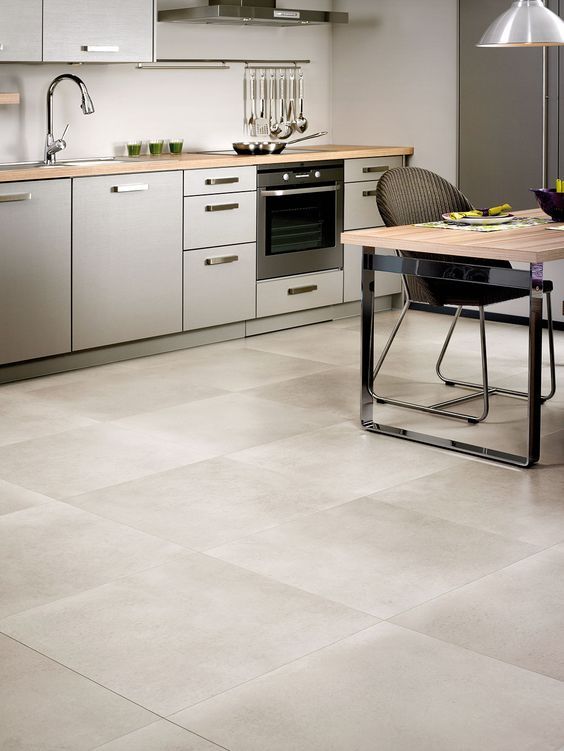 Hardwood floors are strong and durable, provided they are properly installed and treated. It can be parquet, planks of different shapes or boards made of wood of different species. Depending on the type of wood, the properties of the finish vary slightly. But in any case, it is a stylish and expensive decor, warm and pleasant to the touch. Scratches and other defects that appear on its surface can be removed without a trace.
Hardwood floors are strong and durable, provided they are properly installed and treated. It can be parquet, planks of different shapes or boards made of wood of different species. Depending on the type of wood, the properties of the finish vary slightly. But in any case, it is a stylish and expensive decor, warm and pleasant to the touch. Scratches and other defects that appear on its surface can be removed without a trace.
The main disadvantage of wood is its high hygroscopicity. It absorbs moisture and under its influence begins to deteriorate. A fungus or mold appears, the tree rots and collapses. Therefore, regular treatment with special solutions is required. In addition, the wooden surface burns, it must be protected from fire. Strong mechanical influences are undesirable. There may be chips and scratches. True, it is quite easy to get rid of them.
With all the advantages of the material, without special treatment, it cannot be laid in the kitchen. Changes in humidity and temperature will quickly make the wood unusable.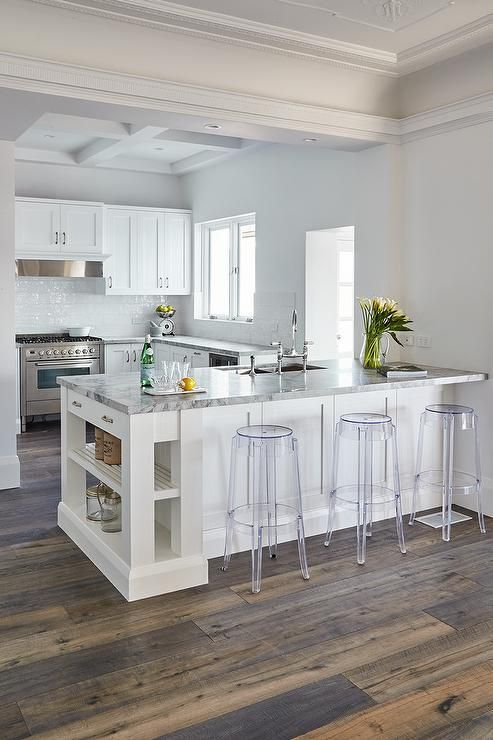 It is best to choose a thermal tree. This is the name of the material processed under special conditions. It is most resistant to moisture and other adverse factors.
It is best to choose a thermal tree. This is the name of the material processed under special conditions. It is most resistant to moisture and other adverse factors.
Design: Natalia Shirokorad
Design: Victoria Baikova. Photo: Natalya Vershinina
6. Self-leveling floor
This is a liquid self-leveling mastic poured onto the base. Usually on a concrete screed. After hardening, a durable wear-resistant coating is formed. The self-leveling floor is immune to impacts, you can put massive furniture on it, drop sharp and heavy objects. There are no traces left. It is completely sealed and waterproof. It is very easy to clean because it does not attract dust. The surface is smooth and easy to clean. You can use any household chemicals.
Liquid mastics come in a variety of colours. An interesting decor is obtained using the so-called 3D-paintings, but you should be careful with the choice of image: the image of an aquarium, a forest or mountain path, a desert is already completely irrelevant and can reduce the cost of the interior.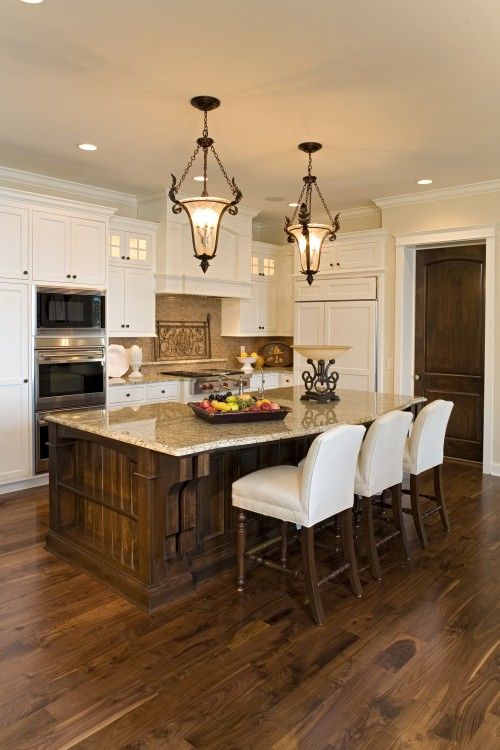
A significant disadvantage of flooring is the dependence on the quality of installation. Even a high-quality mixture can ruin unskilled installation. It is impossible to hide flaws when laying. The downside is usually considered the high price of decor and the fact that self-assembly is not always possible.
Self-leveling coating suitable for kitchen floors. It is durable, moisture and wear resistant, not afraid of temperature extremes and mechanical damage. At the same time, it is easy to care for him.
Design: Ekaterina Chasovskikh. Photo: Olga Shangina
The best choice for the kitchen will be porcelain stoneware, vinyl or quartz vinyl, self-leveling floor. Nothing will happen to them when water gets in, they are quite easy to wash off the most difficult contaminants and will not deteriorate even if a pipe breaks or a serious leak from the dishwasher.
Wood or laminate is a controversial choice when deciding which material is best for a kitchen floor.